
Rock Zone
Best way to shine your music talented
UX Design | Mobile APP
My Role
As a UX/UI designer, I did user research and design work. Rock Zone app took me about five months to complete.
Rock zone is an app for musicians who want to find work resources and socialize with other musicians. This app not only helps musicians find work opportunities, but also helps them find music related resources. Musicians can create their profile to advertise and distribute their music. Linked with social media outlets: YouTube,Instagram, Spotify, Tik-Tok. They can network with other musicians, find gigs and projects, or even hire other talented musicians. Also the app gives users an avenue to buy and sell gear and book rehearsal room space. Any music related resource, you will find in Rock Zone.

Problem
Most musicians are failing to earn enough income to cover basic living expenses. This is due to places that hire musicians such as performing centers or music schools not being able to provide individual musicians with the number of hours they need to make a living. Even with musicians being willing to work multiple places to gain more hours, they are faced with the reality that juggling the schedule of multiple locations will result in time conflicts as well as result in their income being cut by the expense of driving from one location to another. In an attempt to solve this issue, local community groups online should post local job opportunities so musicians will know about all opportunities available to them in their area and not have to drive as far.
Step 1: Research
Secondary Research
Musicians struggle with not getting enough working hours
According to a new report, average American musicians still make under $25,000 a year. Because they are not full-time professionals, and even the ones who are still lead busy lives. Time management is a skill they have to learn if they want to be serious musicians.
Why do musicians not get enough working hours
Musicians often compete with other musicians for a limited number of music related jobs in the city they live. This results in places either giving decent working hours to only a small number of people who they hire, or hiring many of the musicians that apply and dividing up the hours amongst the employees. This results in each getting a small number of working hours.
Consequences of musicians not getting enough working hours
Musicians work multiple places to gain more hours, they are faced with the reality that juggling the schedule of multiple locations will result in time conflicts as well as result in their income being cut by the expense of driving from one location to another.
Current solution for musicians to make a living
To be able to have a stable income, most musicians work multiple part-time jobs to pay their living expenses. Having a part-time job that’s related to music is what musicians want, but many of the jobs are actually in completely different fields.
Alternative solution for Musicians
In an attempt to solve this issue, online local community groups should post job opportunities so musicians will know about all works available to them in their area and not have to drive as far. Also, musicians should adopt more online opportunities to eliminate their commute as well as expand their customer base which will allow them to fill their schedules.
User Research
This study I interviewed a couple of participants working in the music industry. Each participant had a 30 minutes session and included a short interview to let musicians share their experience of their suffering of not making enough money. Among the tasks: ask musicians to share their working schedule and locations and the resources they find work. I also designed the screen survey to send out through social media to let musicians fill out.
Participants
-
Musicians trying to get more work.
-
Age 20-65
-
Working multiple jobs
-
Working multiple locations
-
Full time or part time musician
Screen Survey
After finding participants for user research, I created screen survey to understand the following questions:
-
How many music related jobs do musicians currently have?
-
How many hours do they work at these music related jobs per week?
-
Approximately how many hours do they spend commuting to their music related jobs per week?
-
Excluding their music related job(s), how many other jobs do they currently have?
-
How do they find music related job opportunities (performance, working in a studio, teaching lessons, etc)?
Step 2: Synthesis
I gathered interview transcripts and highlighted things I think it’s important. In the coding step, I categorized highlighted sections so that they can be easily compared. I printed out research questions to remind myself of research objectives. And stuck them up on a wall where conducting the analysis.
Interview Transcript
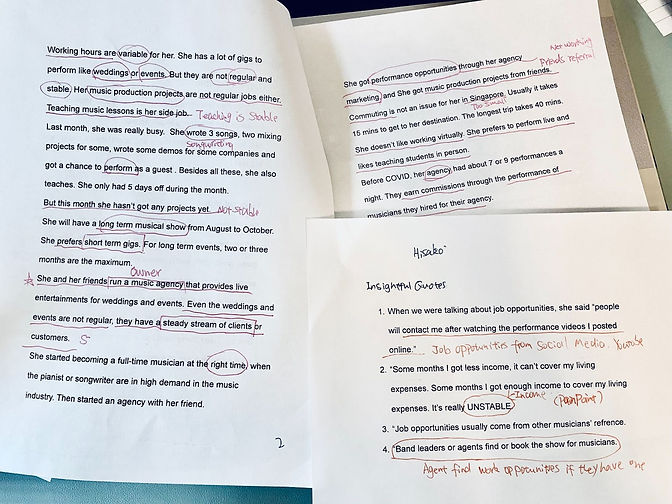
I transferred the codes from transcripts to sticky notes and stuck them on FigJam. Different colors represent different participants.
Affinity Map
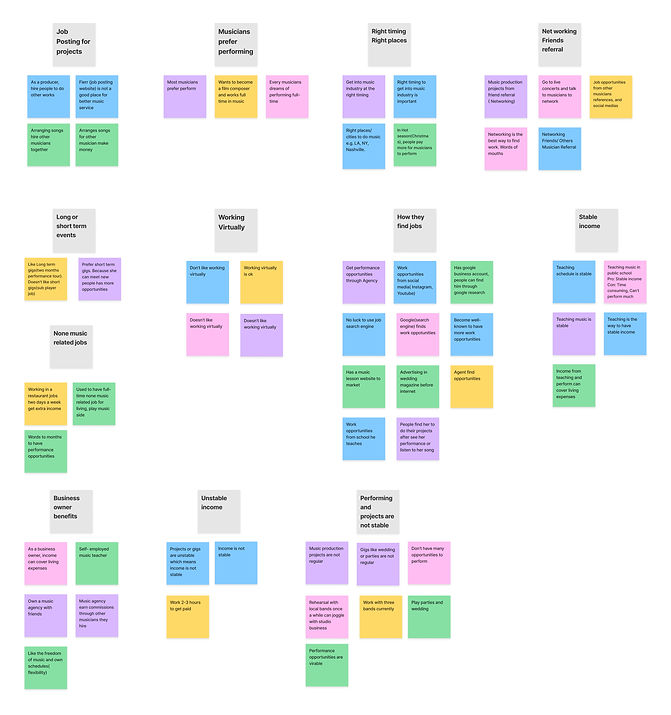
Interview Insights
During the interview I learned about how musicians face financial issues and I felt the strong passion they have for music. These insights led me to focus on what musicians really need and how they want to achieve their goals in music or finance.
Networking is the key to get more opportunity
Networking with other musicians is the best way to find work opportunities. Words months are always the best way. Networking can put musicians in the high-profile field to get to know more people working in the same field. Getting into the category of becoming well-known will have more job opportunities coming.
Stable jobs lead to stable income
Musicians need more stable jobs to have a regular income. Some musicians struggle with not having enough income to cover living expenses in certain months. Creating multiple income streams for musicians is the way to solve this problem.
Distribute or perform music is the best way to advertise music
In music events, people will find musicians and let them do the projects after they see the performance or listen to their music.
Social medias is another way to advertise music
People will contact musicians after watching the performance video they post online. It’s always good to have a personal website or make a business account in google.
Persona
Based on the results of the user interviews, I developed two types of musician personas. One for full time musicians and another for part time musicians. Having the persona established helps me stay focused on the users’ needs throughout the design process.



Empathy Map
Empathy mapping shows how users think, say, do and feel. I observed the user’s behavior during the user interview then collecting data helps me to think from the users’ perspective



How Might We?
Using the personas and empathy mapping as a guide, I created the “How might we…” statements, it helped me understand how to help musicians reach their goal in different ways.
-
How might we help musicians find more work opportunities?
-
How might we increase the stability of a musician's income?
-
How might we find more performances and projects opportunities for musicians?
-
How might we create multiple music related streams for musicians?
-
How might we help musicians network?
Step 3: Ideate
MVP
According to the user research, I designed some features that users want to have in the app and help them accomplish their goals. The MVP was defined as the following:
Profile
Job search and post
Networking
Music Distribution
Music related resources
User Stories
In order to create user stories, I followed MVP as a guide. This section contains the final goals or tasks that the user can accomplish with the product. It shows features or functions that will be provided for users. It also helped me focus on the user's needs.
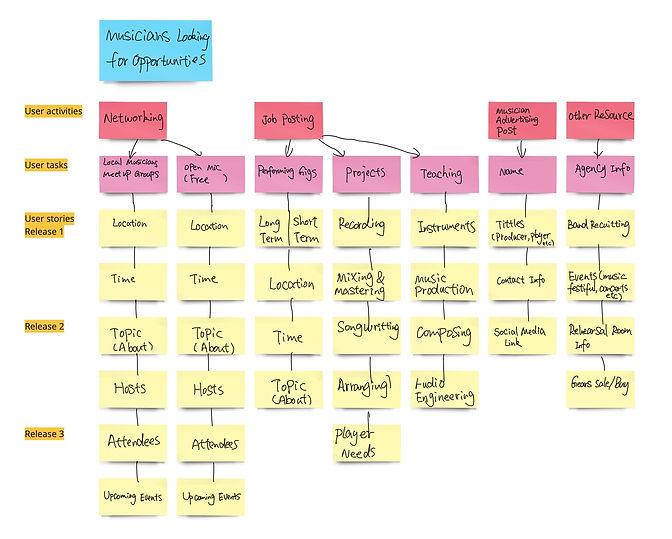
Step 4: Competitive Analysis
The results showed that although major competitors have most of the features that musicians are looking for, none have all of them. It is essential to incorporate all important features so musicians are not forced to download multiple apps. The most important features are musicians being able to post their accomplishments in their profile, network socially with other musicians, and finding jobs.

Step 5: Information Architecture
Sitemap
Once brainstorming generated ideas, the main contents of the app were decided . I created a sitemap which shows the guidance of the Rock Zone app.
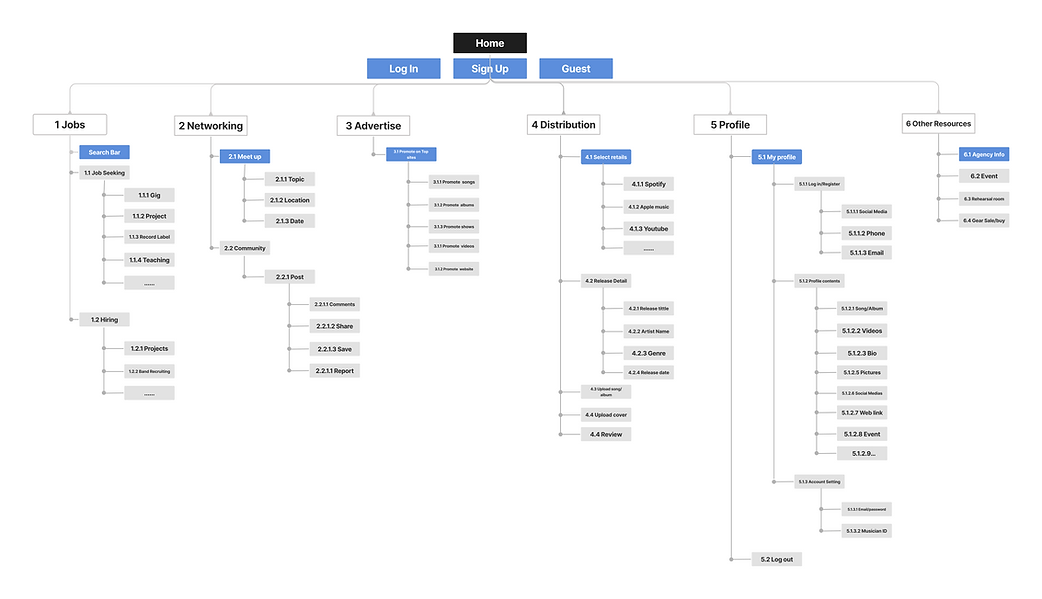
User Flow
Based on user story scenarios I created user flows. Users can create profiles, advertise their music, apply or post a job and socialize with their friends.
User Flow 1: Profile
-
Scenario 1: New user wants to register and complete profile
-
Scenario 2: Existing user wants to edit profile
User Flow 2: Jobs
-
Scenario 1: Existing user wants to find jobs and submit profile
-
Scenario 2: Existing user wants to post jobs on site
-
Scenario 3: Guest wants to find or post jobs need to register first
User Flow 3: Networking
-
Scenario 1: User wants to find local musicians Meetup
-
Scenario 2: User wants to read, write, comment, share posts on community

Step 6: Sketching
Once user flows were created. I started trying to bring the ideas to life. Hand sketches helped me focus on the screen layout and main features, and not be distracted by the details.
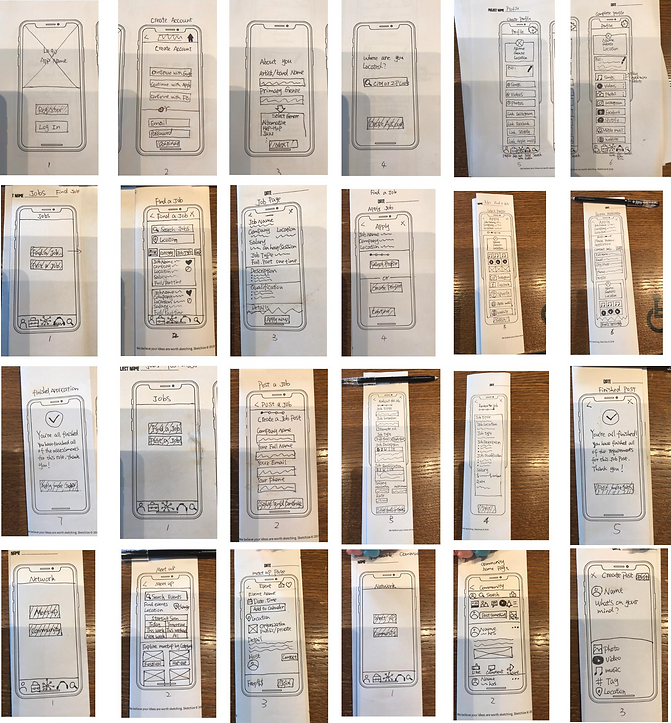
After I finished red route screens. I used the Marvel app to create a paper prototype. I recruited some users to do Guerilla Usability Testing. It’s a quick way to learn what users like or dislike about my designs. I learned I need to improve the speed at which users can go from task to task without needing to hit the back button multiple times. I decided that implementing the home banner, which includes the icons for their profile, jobs, networking, and distribution on the bottom of each page of the app would be the best option to give users a seamless way to get to any task from any screen in the app. Also I need to create a guest route for users who want to explore the app first without registering. If they want to complete more tasks like apply jobs or join a network then take them to the register account page.
Step 7: Wireframing and Wireflow
As I started to design the app, I wanted to see what experience users would have and see interacting with my app in low fidelity. I wanted a digital look of my sketches to give a more accurate representation of what my final product will appear to users, while I used the wireflow to see what my users experience interacting with the app will be.


Step 8: Style Guide and Brand Platform
Colors

Font
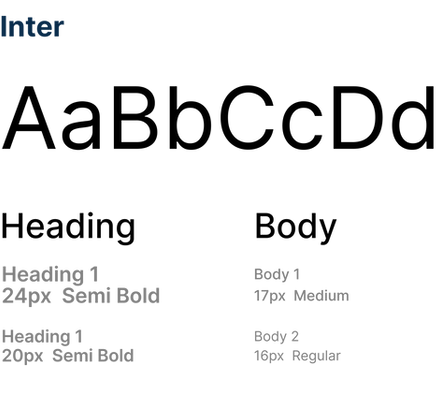
Icons
Style
Profile
Jobs
Network
Distribution
More
Color

#84BDFF
#CE42FE
UI Elements

Step 9 : Usability Testing
I conducted two rounds of usability testing. I Interviewed few people that are either working in the music industry or entertainment industry. Some interviews were moderated tests which were conducted in person or remotely and gave users a prototype to interact and ask follow-up questions, each interview lasted about 30 minutes. Others were unmoderated tests which were only conducted remotely and involved users recording a video of themselves interacting with the prototype.
Task 1 : Create account and complete the profile
Task 2: Apply a job
Task 3 : Post a job
Task 4: Join a meetup event
Task 5 : Post something on community group page
Usability Test Report
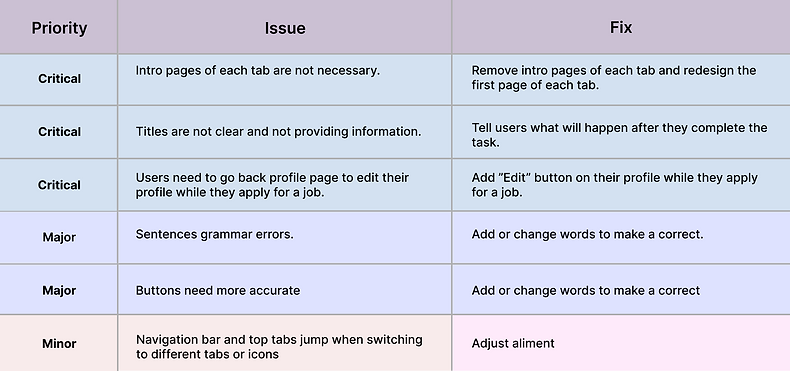
Step 10: High Fidelity Mockups
To create a high fidelity mockup, I involved determining all UI details. I refer to my style guide and brand platform to make the decisions to build high fidelity Mockups. I chose black based screen with blue and pink blended neon style as a primary color creating a feeling of performing on stage . This UI design is meant to fit musicians’ souls and catch their eyes. I also corporated this feeling with font, icon, styling, and imagery, using drop shadows, gradients, line width, and more to create an aesthetic design that is on-brand.

Step 11 : Prototyping
Product Demo
Sign in and profile interaction
Apply a job interaction
Post a job interaction
Meetup interaction
Community interaction
Wrap up
I spent working on this project allowed me to develop a product based on design thinking.Starting from user research allowed me to know about what user’s frustrations are by putting myself in their shoes. Having empathy for users helped me understand what goals they want to achieve. By understanding what they need, it allowed me to brainstorm ideas and solutions for the problems users are facing to create an app that users enjoy to use.
Back
Next